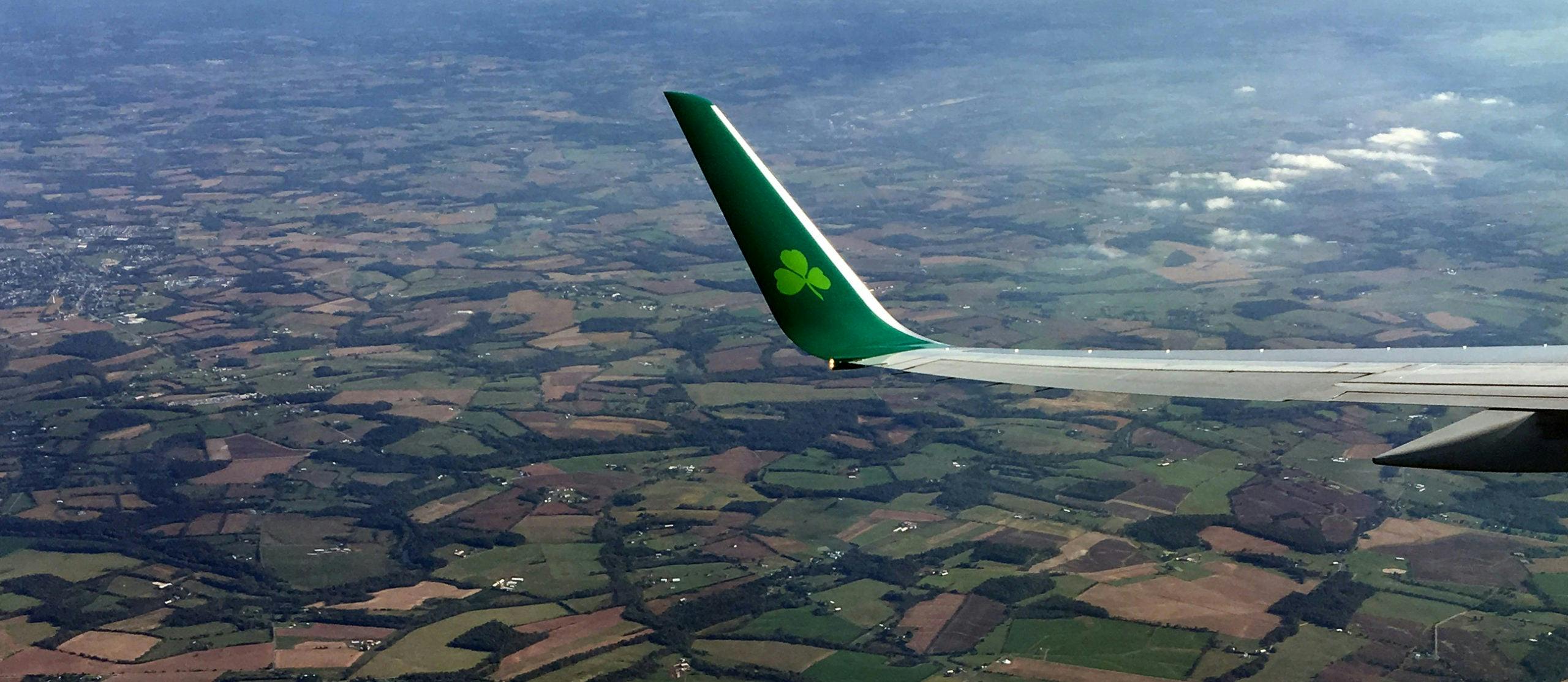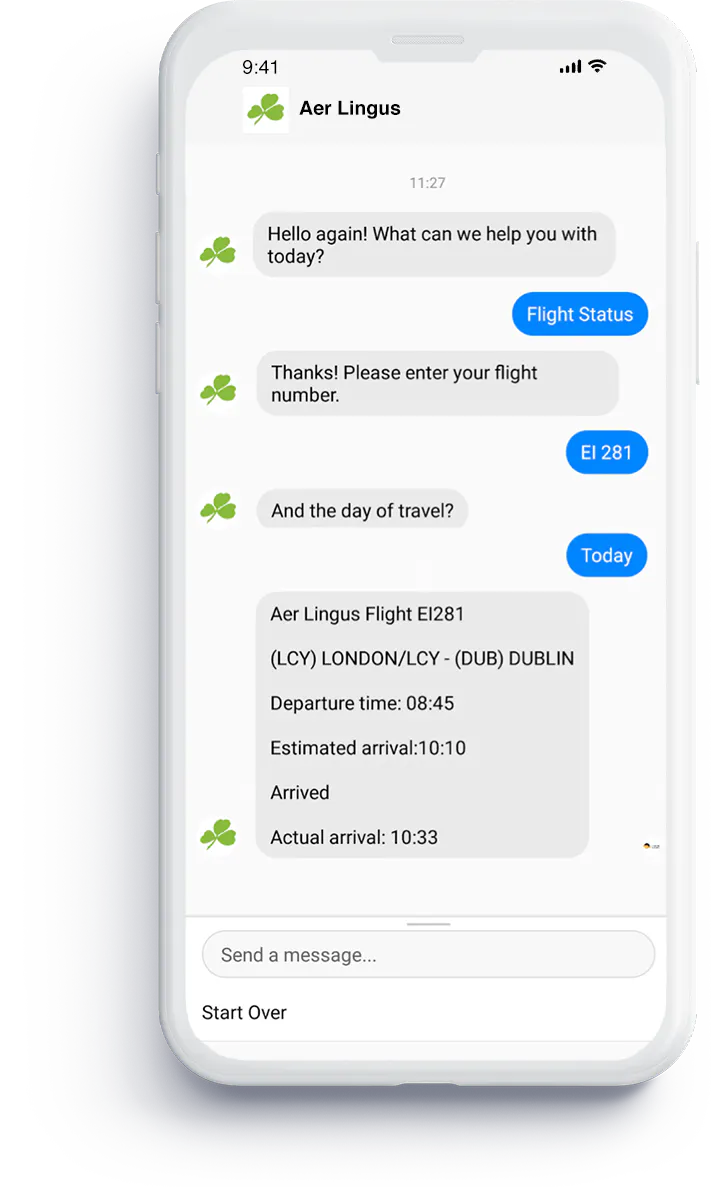Adaptive Automation: Seamlessly Blending Agents and Bots to Deliver Exemplary CX
Aer Lingus, the flag carrier airline of Ireland, is a brand truly invested in delivering a friction free and scalable customer experience. A pioneering airline dedicated to digital innovation, Aer Lingus have transformed their customer service offering by investing in adaptive automation, spearheaded by a tier-1 flight status service chatbot.

Aer Lingus’ Digital Journey
For airlines, passenger relationships are the most valuable ticket to long-term success. Aer Lingus recognise that 1:1 interactions with their digitally-savvy fliers creates a great CX – the foundation for satisfaction, loyalty and ultimately, customer retention. With digital channels transforming how travellers engage with Aer Lingus, the airline understood that to reach the heady heights of success, scalable and enterprise-grade care was needed.
Partnering with Conversocial, A Verint Company, in September 2013, Aer Lingus set the goal to go the extra mile with their customer service operation by efficiently managing and responding to their ever-increasing digital volumes. Delivering a first-class service with the help of a Conversational CX Platform would ensure that Aer Lingus could provide a seamless customer experience to their digital passengers.
With a long-term vision aligned with quality, choice and convenience, Aer Lingus have continuously innovated and adopted new features and functions, such as private messaging channels and more recently, automation, to propel their customer service strategy into the digital world.
This is a carousel with slides that do not auto-rotate. Use the Next and Previous buttons to navigate.
The Coming of Age: Messaging & Adaptive Automation
For Aer Lingus, private messaging channels, and in particular Facebook Messenger, offer a unique opportunity to engage with digital customers. Messaging is:

PERSISTENT
Singular, continuous conversation.
DEVICE-AGNOSTIC
Conversation moves with the customer.
IDENTIFIABLE
Always conversing with a customer.
BUILT FOR AUTOMATION
Continual improvement through ML/NLP.
Alongside messaging, innovative brands like Aer Lingus, are now figuring out how to use bots to add real value to the overall customer experience and help scale their digital care operation. Previously in the CX domain, it was much harder to automate full conversations there are just too many variables for what a customer could ask. But messaging channels are different. Humans and automation can sit side-by-side in a way that has not been possible before.
Done right, the messaging advantage for bot-automated interactions has clear and positive business impacts. Helping brands:
- Deliver better customer experiences: Automation of common enquiries results in quicker response times and faster time to resolution for customers, decreasing effort and increasing customer loyalty.
- Scale digital volumes: Service bots help brands manage high volume, low effort queries. Used as a frontline triage, bots should resolve repetitive, simple issues while highly skilled agents are dedicated to high-value interactions—creating big savings in customer service costs.
- Lower their cost-to-serve: Bot-ready platforms that combine both adaptive automation and agent-assisted service results in fewer enquiries needing a human response. Meaning highly skilled agents are free to handle more complex customer service enquiries
- Enable increased revenue: With the addition of payments, full commerce is now possible within messaging channels. When combined with the ability to send consumers targeted notifications and content with much higher open rates than email (as long as they opt-in). This is a huge untapped revenue source.
The partnership between messaging and automation is, however, often hard to get right.
Success requires an approach that combines the unique nature of messaging with human agents and adaptive automation to create scalable Conversational Customer Experiences. This combines the best aspects of messaging automation and human interaction to make connecting with a business as easy as messaging a friend.
Working seamlessly together, bots and human agents can turn CX into a competitive differentiator. This balance is exactly what Aer Lingus have achieved with their tier-1 service bot on Messenger.
Aer Lingus' Business Case For a Service Bot
Efficiently managing ever-increasing volumes on messaging channels has been a long-standing goal for Aer Lingus. The catalyst for this, however, came in March 2018 when Storm Emma brought Aer Lingus their highest incoming volumes since the launch of their digital care operation.
With exacerbated levels of disruption, flight uncertainty and repetitive inquiries about flight status, Aer Lingus’ agents struggled to identify conversations which needed to be escalated for swifter issue resolution. Other challenges faced by the team included:
- Scaling to meet volume surges
- Resourcing appropriately
- Maintaining SLAs
As an airline committed to improving the customer experience, Aer Lingus faced the question: How could they create a scaled digital service operation to provide the most friction free and prioritized experience to customers seeking resolution on digital channels?
With a large percentage of digital volumes coming through Messenger, Aer Lingus decided to implement adaptive automation, with a tier-1 service bot, into their digital care architecture. Aer Lingus deployed their flight status bot in December 2018, just in time for their busy holiday season.
Operationalising Aer Lingus' Tier-1 Service Bot

Phase 1: Requirement Scoping
Automation Consultants conducted workshop sessions to understand Aer Lingus overall requirements:
- Agent hand-off
- Natural language phrasing
- API availability
- Delivery timelines
- Resources
- Authentication against Aer Lingus social pages
Phase 2: Delivery
Engineers and Automation Consultants built and configured desired Bot workflow:
- Bot hosting
- Social network approval(s)
- API connection/testing
- Bot scripting
- Agent hand-off configuration
Phase 3: Testing
Automation Consultants worked with Aer Lingus to validate design and effectively QA:
- Sandbox setup
- Internal QA
- Customer UAT
- Refinements
Phase 4: Support
Automation Consultants implemented Bot and supported transition:
- Transition to live social pages
- Support in line with business hours
- Refinements based on customer behaviour
The Result
 1. ADAPTIVE AUTOMATION
1. ADAPTIVE AUTOMATION
Aer Lingus’ tier-1 service bot is designed to handle simple flight status requests over Messenger, sourcing this information in a single, smart interaction. Delivering flight status information via the same API as aerlingus.com and mobile app means Aer Lingus’ digital architecture is smartly aligned for a more consistent experience. Dynamic conversational experiences driven by Random Access Navigation (RAN), proprietary technology to Conversocial, A Verint Company, gives customers the ability to navigate through intent and interaction history without a predefined path.
2. BLENDING HUMANS AND AUTOMATION
Working seamlessly together, the Messenger bot and human agents are empowered to turn Aer Lingus’ customer service into a competitive differentiator. Aer Lingus can provide a scalable CX, to all their customers on Messenger, striking the right balance between adaptive automation and human support. For complex issues or instances where the bot is unable to collect all of the correct data, it can smoothly handover any conversation to human agents for resolution. Adding value to Aer Lingus’ digital strategy, the bot frees up agents to efficiently manage priority interactions or those which need an empathetic human touch.
3. PURPOSE BUILT FOR MESSAGING
The tier-1 service bot has helped Aer Lingus transform Messenger into a channel best-positioned to deliver conversational customer experiences. Digital interactions with Aer Lingus now have the same flexibility of real-world conversation, with the ability to switch topics and, in some cases, context. Based within Messenger, the bot facilitates single, continuous conversation with customers via private messaging. For Aer Lingus, this has revolutionized their engagement strategy by capitalising on digital CX through Messenger.